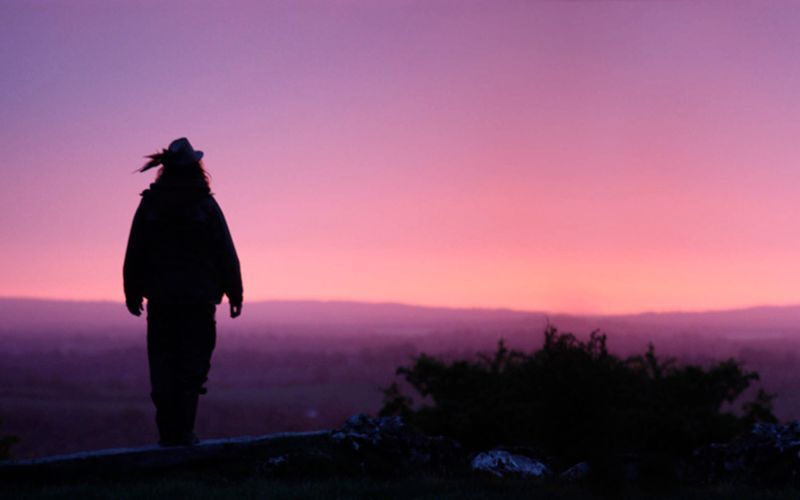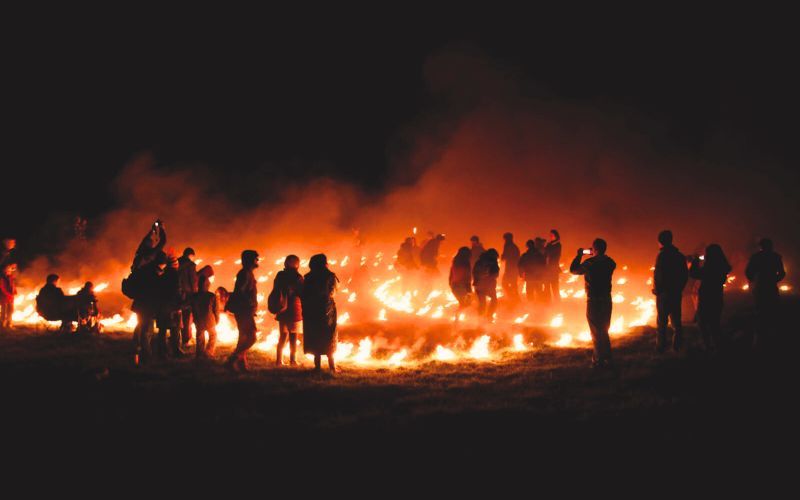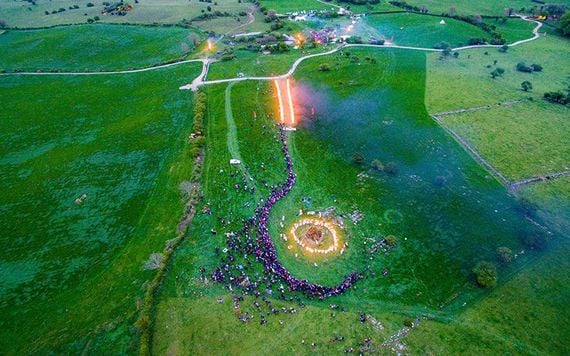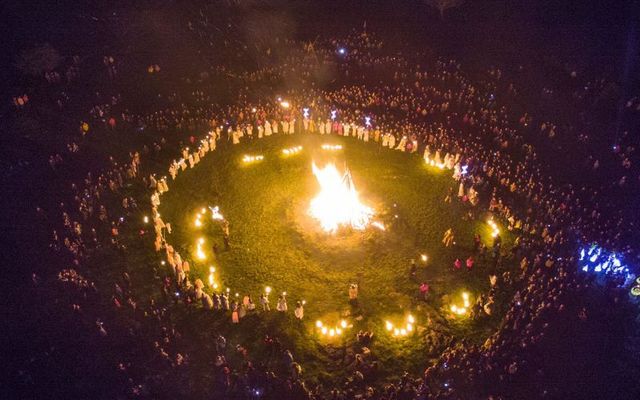According to Irish mythology, this time, Bealtaine (May 1) was a very important time for our ancient Irish ancestors - it marked the first day of summer and was known as Bealtaine.
Legend has it that the festival of Bealtaine was particularly associated with the Hill of Uisneach- "Cnoc Uisneach" in Irish- in County Westmeath, and like most ancient Irish festivals, it was celebrated with fire.
Archaeology has confirmed this possibility with the uncovering of extensive layers of charcoal and other burnt material on the hill, consistent with the lighting of huge fires.
The meaning of the name Uisneach is uncertain. It is said to come from the Irish word for water, "uisce" (pronounced ish-ka) and a little-known god of the Tuatha de Danann named Nechtan.
The Book of Invasions, "Lebor Gebála Érenn" in Old Irish, tells us that the first Bealtaine fire ever lit in Ireland was kindled by the Nemedian Druid Mide, at Uisneach.
At 600 feet high, the hill is not tall, yet 20 counties can be seen from the summit on a clear day. Historically and mythologically, it was regarded as the center point, or 'naval' of Ireland, symbolized by the presence of a great stone called the Ail na Mirean, or Stone of Divisions.

Hill of Uisneach, Rathconrath, Co Westmeath (Ireland's Content Pool)
This limestone boulder stands close to 20 feet tall and is estimated to weigh thirty tons. Sometimes known as the Cat Stone due to its resemblance to a pouncing cat (you have to squint a bit, and use your imagination when looking at it), it is also said that the Danann Goddess Eriu, who gave her name to Ireland, is buried beneath it.
The Stone of Divisions sits on the southwest side of the Hill in a circular enclosure, where it was believed the borders of Ireland's five provinces, Leinster, Munster, Connacht, Ulster, and Mide met. Nowadays, there are only four provinces; ancient Mide being absorbed into the counties Meath and Westmeath.
This archaeologically rich site also contains the remains of circular enclosures, barrows, Cairns, a holy well, and two walkways, or ancient roads, spread over a slightly over a one-mile area.
In fact, one of the roads has actually been discovered to connect the Hill with the nearby, more well-known site of the Hill of Tara. Whilst Tara was associated with Kingship rituals, Uisneach is believed to have been a place of Druid worship and ceremony.
On Uisneach’s summit lies Lough Lugh. Here, according to legend, the Danann High King, Lugh of the Long Arm - "Lugh Lamfháda" in Irish - was said to have been drowned after a fight with the three vengeful sons of Cermait and buried beneath a cairn beside it.
In later times, St. Bridget is said to have taken the veil from St. Patrick, and the holy well on the hill is named in her honor.
The Irish are well known for their hospitality, their love of a good party, and a bit of craic; the same was true of our ancestors. While we can’t know exactly what went on around those ancient fires, they likely symbolized pagan ritual and religious belief. It is quite possible that they also represented a time of celebration, joy, music, dancing, feasting, and fun for the whole community.
In 1943, an old Limerick schoolmaster wrote about his childhood memories of an unusual Christian celebration of St. John’s Eve. He described how great bonfires were lit at sunset, and how the women prayed for plentiful crops and good weather, while the men competed in sports.
There was music and dancing. Children attempted to juggle burning sticks taken from the fire. The more foolhardy took turns at trying to leap across the fire. Flaming torches would be carried around the fields, and as the bonfire died, embers would be taken home to relight the family hearth. Ashes from the fire would then be sprinkled across the fields the next morning.
These activities were clearly watered-down, Christianized versions of pagan ritual. Of particular note is the leaping of the fire; some say this is a remnant of human sacrifice, yet there is no evidence to support this, either mythical, historical or physical.

Festival of Fires, Hill of Uisneach, Rathconrath, Co Westmeath. (Ireland's Content Pool)
Around the world, the use of fire and smoke have long been seen as cleansing and purifying, and this may have been the original purpose of leaping the fires, passing between them, or indeed fire-walking.
As late as the 19th century, peasants were observed herding their cattle between bonfires at Bealtaine, en route to highland summer pasture. The heat and smoke may have killed off any external parasites and blessed the herd’s fertility and milk production. Irish mythology also mentions this custom.
The Tuatha de Danann was famous for their milk-white cattle. Under the tyrannical rule of their High King Bres, they were required to pay him a large annual cattle tribute. One year, legend has it, they defied him by driving the animals between the fires. The soot and smoke ruined their fine white coats, thus Bres no longer coveted them.
Applying fire to fields in order to clear them of weeds, nourish the soil, and prepare it for planting is something that farmers have been doing for many hundreds of years. It is certainly possible that our ancestors may have viewed this vital act as something sacred.
Although the festival of Bealtaine faded following the arrival of Christianity to Ireland in the fifth century, its legacy remained irresistibly strong at Uisneach. Finally, the custom was revived in 2009 with the Festival of the Fires, an event which has proved enormously popular.

May 6, 2017: The Uisneach Fire Festival draws on ancient traditions to celebrate May 1 and the Celtic holiday of Bealtaine. (RollingNews.ie)
The modern brings back to life many of these ancient ceremonies. Organizers previously said: “The Uisneach Fire Festival's unique ceremonial fire parade at dusk will be the centerpiece of the day-long celebration which will also feature artisan foods and crafts, holistic healing, a heritage talks tent, re-enactments and guided heritage walks.”
The experience of fire is quite a feast for the senses; there's something hypnotic and beguiling about watching golden flames leap high into a night sky, fanning your face with melting warmth, while the hiss, pop, and roar as they consume their fuel fills your ears and clouds of fragrant wood smoke drift around you.
Add to this the primeval beat of drums, the chant of voices, the whirling of dancers in strange fantastical costumes, the anticipation of an expectant crowd, the brooding cloak of darkness lurking on the periphery, combined with the press of our mysterious past, and one begins to get a sense of what Bealtaine may have felt like to our ancestors.
You can find more on the Uisneach Fire Festival here.
*Ali Isaac lives in beautiful rural Co Cavan in Ireland, and is the author of two books based on Irish mythology, “Conor Kelly and The Four Treasures of Eirean,” and “Conor Kelly and The Fenian King.”
*Originally published in 2015. Updated in May 2024.




Comments